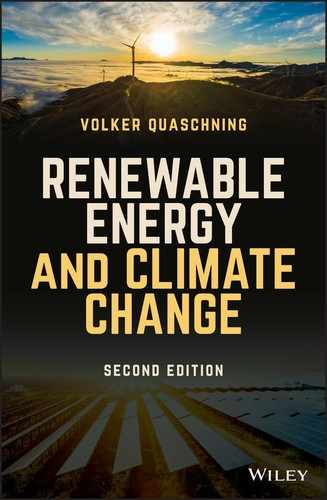CHAPTER 12
Biomass – Energy from Nature
Humans have been using energy from firewood for at least 790 000 years – ever since Stone Age people discovered how to make fire (Figure 12.1). This makes biomass the oldest renewable energy source by a huge margin. In fact, biomass was the most important energy supply worldwide well into the eighteenth century. Even today some countries like Mozambique and Ethiopia use traditional biomass to cover over 90% of their primary energy needs.
As the use of fossil energy supplies grew, biomass use was almost non-existent in the industrialized nations. In 2000 the share of biomass in the primary energy supply in countries such as Britain, Germany, and the USA was not even 3%.

Figure 12.1 People have been using the energy from firewood for thousands of years.
Biomass started to become popular again even in the industrialized countries when oil prices began rising dramatically at the beginning of the twenty-first century. In addition to its traditional use in the form of firewood, modern forms of biomass are now being exploited. Biomass is not only used in simple open fires, but also to operate modern heating systems and power plants for generating electricity, as well as to produce combustible gases and fuels.
12.1 Origins and Use of Biomass
The term ‘biomass’ refers to a mass of organic material. It comprises all forms of life, dead organisms and organic metabolism products. Plants are able to create biomass in the form of carbohydrates through photosynthesis. The energy needed is supplied by the sun (Figure 12.2). Only plants carry out this process; animals can produce biomass only from other biomass. This is why all animals would starve to death without plants.

Figure 12.2 The sun is responsible for the growth of biomass on Earth.
 Origin of Biomass
Origin of Biomass
Through photosynthesis plants convert carbon dioxide (CO2), water (H2O) and auxiliary substances like minerals into biomass (CkHmOn) and oxygen (O2):

In the simplest case, so-called oxygenic photosynthesis produces glucose (C6H12O6):
Almost all the oxygen in the Earth's atmosphere is formed through oxygenic photosynthesis. Therefore, the oxygen we need in order to breathe is a pure by-product of biomass production.
Biomass is distributed in many different forms throughout Earth. In addition to solar energy, water is essential for the growth of biomass. Even the solar energy in the northernmost regions of the world is sufficient to create biomass. Regions with water shortages, however, have low biomass growth (Figure 12.3).

Figure 12.3 The view from space – vast areas of water cover the globe.
Source: NASA.
Plants therefore convert sunlight into biomass using natural chemical processes. An efficiency can also be established for this process. As a result, land usage for biomass cultivation is comparable to other renewable energy technologies such as solar systems. A plant's efficiency is determined by dividing the calorific value of dried biomass by the solar energy that reached the plant during its growth phase.
On average, including deserts and oceans, the efficiency of biomass production on Earth is 0.14% [Kle93]. Despite the comparatively low efficiency, biomass is created worldwide with an energy content that corresponds to about 10 times our entire primary energy requirements.
Yet not all biomass can be used as energy. Human beings currently use around 4% of new biomass. Two percent goes into food and fodder production and 1% ends up as wood products, paper, or fibre. Around 1% of newly created biomass is used as energy – usually in the form of firewood – and it therefore covers about 10% of the world's primary energy demand.
The plants that reach the highest efficiency during the conversion of sunlight into biomass are C4-plants. These plants have a rapid photosynthesis and, as a result, use solar energy particularly effectively. C4-plants include amaranth, millet, corn, sugarcane, and willow. Under optimal conditions these plants achieve efficiencies of 2–5%.
With biomass a distinction is made between the use of waste from agriculture and forestry and the selective cultivation of energy plants. In Germany studies have shown there is a total potential of around 1200 petajoules per year (Table 12.1). This equated to about 8% of Germany's primary energy needs in 2005. The potential should be similar for other industrialized countries with a high population density. Even if extensive energy-saving measures are implemented, biomass can still only cover part of the energy demand.
Table 12.1 Biomass potential in Germany [Kal03]
Useable quantity in millions of tonnes |
Energy potential in PJ/a |
|
| Stalk-type (straw, grass) | 10–11 |
140–150 |
| Wood and wood residue | 38–40 |
590–622 |
| Biogas substrate (biomass waste and residue) | 20–22 |
148–180 |
| Sewage and landfill gas | 2 |
22–24 |
| Energy plant mix | 22 |
298 |
| Total biomass potential | 92–97 |
1198–1274 |
There are many different possibilities for biomass use (Figure 12.4). The biggest potential exists with wood and wood products. Waste from agriculture and forestry and biogenic waste are also important from an energy perspective. In addition to waste use, special energy plants can be grown. However, as energy plants compete with food production for arable land, there is some controversy over large-scale cultivation of these plants.
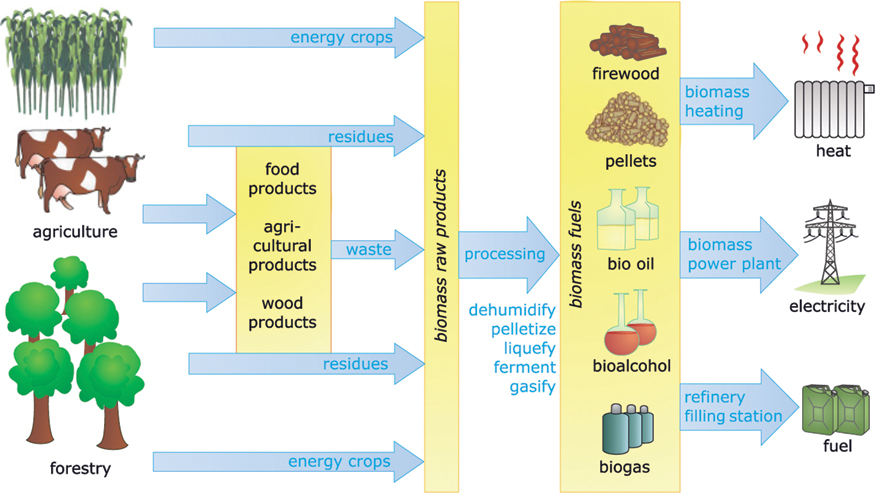
Figure 12.4 Possibilities for biomass use.
The next step is processing the biomass materials. These materials are dried, compressed, fermented into alcohol, converted into biogas, pelletized or processed into fuel in chemical plants. The aim of the processing is to produce useable biomass fuels.
This biomass fuel has the same spectrum of use as fossil fuels like coal, crude oil, and natural gas. Biomass power plants can use biofuels to generate electricity; biomass heating can satisfy heating needs; and biofuels can be used to run cars and other vehicles.
The versatility of biomass use has led to a real interest in alternative fuels. In many industrialized countries like Germany and Britain, however, biomass falls far short of becoming a complete replacement for fossil fuels. Nevertheless, biomass fuels will play an important role in the renewable energy sector in the future.
12.2 Biomass Heating
With traditional biomass, the focus has been on the generation of heat for cooking and heating. Even today the use of biomass for heating is one of its key applications. Wood, straw, and biogas are the commonly used fuels. Wood, straw, and biogas are the commonly used fuels. Vegetable oils and bioalcohol are also used in some heating systems.
12.2.1 Wood as a Fuel
Wood is by far the main fuel used for biomass heating. It is available in different processed forms (Figure 12.5). As the first step, felled trees are cut to a common length to produce round wood. High-quality woods are not used as fuel but are processed further by the timber industry.

Figure 12.5 Different processed forms of wood. From top left to bottom right: round wood, firewood, wood briquettes, wood pellets.
The round wood is then cut up, either by hand or by machine, to produce firewood. Wood scraps or inferior-quality wood may be processed into wood shavings, which can be made into wood briquettes or wood pellets. Special compression techniques are used to press the wood into the right shape for burning. The natural lignin of the wood serves as a binder, so no additional binders are required.
Because of their uniform shape and small size, wood pellets are an ideal fuel. They can easily be delivered in bulk tankers and then blown into special pellet stores. This eliminates the need for time-consuming manual loading. Automated feeding systems enable wood pellet heating systems to provide the same level of heat and ease of operation as natural gas or oil heating systems.
Some isolated quality problems existed in the early days of wood pellet production. Pellets that are the wrong size can get stuck in conveyor systems. If the pellets have not been compressed sufficiently, they can disintegrate too quickly and block up a system. Therefore, wood pellets should comply with current standards, such as the EU standard EN 14961-2, which was published in 2010. In addition, there are pellet certification schemes such as the ENplus seal, which not only certifies the quality of the pellet production, but also takes into account retail and logistics aspects. Wood pellets must conform to the following specifications:
- Diameter: 6 ± 1 mm or 8 ± 1 mm, length: 3.15–40 mm
- Calorific value: Hi: 16.5–19 MJ kg−1 or 4.6–5.3 kWh kg−1
- Bulk density: greater than 600 kg m−3
- Water content: less than 10%, ash content: less than 0.7% or 1.5%
- The new standard CEN/TS 14961 applies to all future production of wood pellets.
A pile of pellets weighing one ton takes up 1.54 cubic metres of space and has a calorific value of 5000 kW h. This equates to a calorific value of approximately 500 l of heating oil. Therefore, two kilos of wood pellets can replace one litre of heating oil.
 A Tree – the World Record Holder
A Tree – the World Record Holder
An 80-year-old beech tree reaches a height of 25 m (82 ft). The crown of the tree has a diameter of 15 m (49 ft) and contains about 800 000 leaves. If the leaves were spread out lying next to one other on the ground, they would cover an area of about 1600 square metres (0.4 acres). This beech tree supplies the oxygen needs of 10 people and in the process absorbs large quantities of carbon dioxide. The 15 cubic metres of wood of this beech have a dry mass of 12 tons, of which around six tons are bound to pure carbon. This corresponds to the carbon content of 22 tons of carbon dioxide.
Yet even this massive beech is dwarfed by some tree species. The majestic sequoia reaches heights of up to 115 m (377 ft), diameters of 11 m (36 ft) with a circumference of over 30 m (98 ft) and volumes of 1500 cubic metres. Not only do trees reach an impressive size, but they can also live to a very great age. Some pine trees live for 5000 years. There is a special type of pine where the rootstock can even survive for more than 10 000 years. New shoots that sprout from them ‘only’ live to about 2000 years. As a result, trees are presumed to be the oldest, highest, and heaviest living things on Earth.
If one were to compress wood shavings into a cube with sides each 1 m long, the mass and calorific value of this cube would be considerably higher than a cubic metre of wood pellets. The reason is that a relatively large amount of air is trapped within a pile of pellets.
In technical jargon, the measure of capacity for one cubic metre of solid wood mass without any gaps is also called a solid cubic metre. When round wood or firewood is stacked very neatly, air gaps occur. The measure of capacity in this case is called stacked cubic metre. When firewood is thrown loosely on a pile, the air gaps increase. In terms of measure of capacity, this is referred to as bulk stacked cubic metre (BCM). The various measurements of capacity can be converted approximately into one another, with the exact factors depending on the type of wood and the shape the wood takes:
- 1 solid cubic metre = 1.4 stacked cubic metres = 2.5 bulk stacked cubic metres (BCM)
As we all know, wet wood burns poorly, because the calorific value of wood depends critically on water content. Damp wood is also heavier than dry wood. This means that not only the wood itself but also the water it contains has to be transported. The water evaporates when the wood burns. However, to evaporate, it needs energy – which in turn comes from the wood. The calorific value drops as a consequence.
Either the wood moisture or the water content is used to indicate the drying level. As both quantities have different parameters and their values therefore differ considerably, this can lead to some confusion. The water content describes the proportion of water in wet wood. On the other hand, the wood moisture indicates the mass of water contained in ratio to the mass of totally dry wood. If exactly half the weight of wood consists of water, the water content is 50% but the wood moisture level is 100%.
Completely dry wood with 0% water content is referred to as bone-dry wood. For example, bone-dry beech trees have a calorific value of 5 kWh kg−1. When wood is dried outdoors, its water content reduces to between 12% and 20%. The wood should be chopped as early as possible into small pieces, covered and then left to air dry for at least one year, but ideally two years. Wood that has been allowed to dry in covered areas can even end up with water content of less than 10%. Even with 15% water content, the calorific value of beechwood is still 4.15 kWh kg−1. With freshly cut wood with a water content of 50% the calorific value drops to 2.16 kWh kg−1 (Figure 12.6). Consequently, its calorific value is considerably less than half that of bone-dry wood.
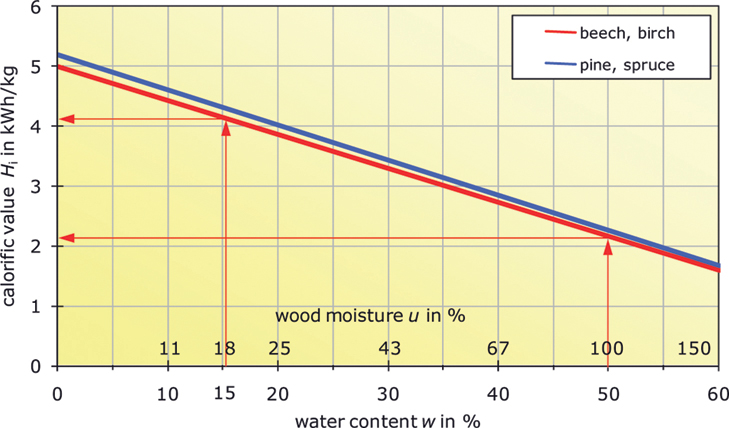
Figure 12.6 Calorific values of wood depending on wood moisture and water content.
This example shows that firewood should be well dried before it is burnt to extract the optimal energy content. The mass-related calorific value per kilogram differs minimally with different types of wood. On the other hand, the volume-related calorific value, thus the calorific value of a solid cubic metre or a stacked cubic metre, varies considerably (Table 12.2). Heavy wood like beech burns longer than light spruce.
Table 12.2 Characteristics of different types of firewood
| Calorific value dried | Density dried | Calorific value Hi with w = 15% | |||
| Hi0 in kWh/kg | In kg/solid cubic metre |
In kWh/kg | In kWh/solid cubic metre |
In kWh/stacked cubic metre |
|
| Beech | 5.0 | 558 | 4.15 | 2720 | 1910 |
| Birch | 5.0 | 526 | 4.15 | 2570 | 1800 |
| Pine | 5.2 | 431 | 4.32 | 2190 | 1530 |
| Spruce | 5.2 | 379 | 4.32 | 1930 | 1350 |
In addition to providing poor calorific values, too much moisture in wood also has some other undesirable effects. High water content means that wood is being burnt under less than optimal conditions. As a result, it releases a high amount of harmful substances and produces unpleasant quantities of smoke and a pungent smell.
![]()
Information on renewable resources Deutscher Energie-Pellet-Verband e.V. |
12.2.2 Open Fires and Woodburning Stoves
The classic biomass heating system is the fireplace. For centuries open fires have been used to heat individual rooms. Yet this is a relatively inefficient use of firewood. Open fires usually only reach 20–30% efficiency. This means that 70–80% of the firewood's energy escapes unused through a chimney. As romantic as old castles and palaces may seem, the use of open fires to achieve consistently pleasant room temperatures in draughty castle halls was an almost hopeless task.
With 70–85% efficiency, woodburning stoves are considerably more effective than open fireplaces. A glass panel in front of the stove can be opened to resupply it with wood and then closed after it has been lit. In principle, stoves can also be used to heat up domestic water.
Woodburning stoves are normally only used as supplementary heating systems because of the work involved in cleaning and lighting them, and replacing the firewood.
One of the main problems with stoves is that they need a relatively large amount of air. In addition to the air needed to enable a fire to burn well, large amounts of unused air escape through the chimney. A fresh air supply from outdoors to burn a fire is essential for well-insulated and airtight houses (see Figure 12.7).

Figure 12.7 Free-standing stove (left) and tiled stove, also referred to as Kachelofen (right).
Source: Bosch Thermotechnik GmbH.
12.2.3 Log Boilers
The log boiler is an option for those who want to heat with reasonably priced firewood and without the inconvenience of a stove (Figure 12.8). As these boilers are usually installed in a basement or utility room, they do not have the aesthetic merits of a fireplace. They have large containers for wood supplies that need to be stocked manually, and they can burn for several hours on a single load of wood.

Figure 12.8 Solid fuel boiler for heating with logs.
Source: Bosch Thermotechnik GmbH.
Compared to the top burn-up of fireplaces where the flame rises upwards, many boilers work with the burn-up at the bottom or on the side. Air is fed into the boiler so that the flame is pointed either downwards or to the side. This increases burning time and cuts down on emissions. The controls, which mainly regulate air supply, ensure that a boiler is burning at an optimal level and adapt it to the heating requirement. Log boilers are available in different performance classes and reach maximum efficiencies of more than 90%. The efficiency of smaller boilers is usually somewhat less.
As log boilers cannot be regulated downward to any specific temperature desired, the installation of a buffer tank is recommended. This will enable a boiler to work under optimal operating conditions at all times. The tank absorbs the excess heat and then continues to supply the heating needed after the firewood has burnt down. The combination of a log boiler with a solar thermal system is a good idea because the boiler can be switched off completely in summer when there is very little need for heating.
12.2.4 Wood Pellet Heating
Wood pellet heating systems offer by far the greatest ease of operation. The fuel is kept in a special pellet store, and an automated feed mechanism using either a feeding screw or a suction device transports the pellets directly to the burner. A screw conveys the pellets from the bottom part of the store. With a suction device similar to a big vacuum cleaner the pellets are also sucked up from below. The suction hoses are very flexible and even enable the bridging of large distances between the store and the burner. As the suctioning of the pellets can be noisy, modern pellet boilers have a small hopper from which the pellets are conveyed to the burner through gravity or a small feeding screw. The hopper is then filled from the store via an automatic timer switch so that the pellet feeding system does not disturb anyone at night.
Ideally, the store would be in a basement. It should be big enough to cover fuel requirements for one year. If a basement is not available, the pellets can also be stored in special silos in a large utility room or in an adjoining shed. Waterproof tanks in the ground are also suitable for stocking pellets. Normally, the store will have two openings (Figure 12.9). The pellets are blown in directly through one opening from the tanker truck that delivers them. The displaced air from the blowing process escapes through the other opening. As the blowing-in of the pellets creates a great deal of dust, a filter traps the wood dust before the air is let out again.
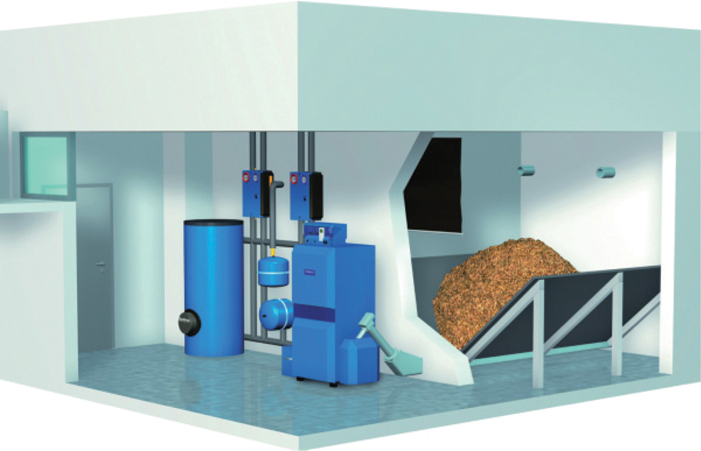
Figure 12.9 Wood pellet heating with pellet store.
Source: Bosch Thermotechnik GmbH.
The controls of pellet boilers always ensure that an adequate supply of pellets is available, thereby guaranteeing that the operation of the system is fully automated. The flame is also lit automatically by an electric hot-air blower. When the required heating level has been reached, the heating system switches off again independently. Another feeding screw transports the accumulated ashes to a special ash pan. Wood pellet heating therefore does not require any manual intervention for its daily operation. As with log boilers, buffer storage should be installed to reduce the frequency with which a fire has to be lit.
Wood pellet heating requires a very small investment of the user's time. The soot and ash residue has to be cleaned out of the pellet boiler room every second month or so. In addition, the ash pan should ideally be emptied once or twice a year. The ash can be used as fertilizer in the garden.
In addition to boilers designed for basements or utility rooms, attractively designed pellet boilers, with the flame visible through a glass pane, are available for use in living areas (Figure 12.10). Here, too, a suction device conveys the pellets from the store that would still be located in the basement.
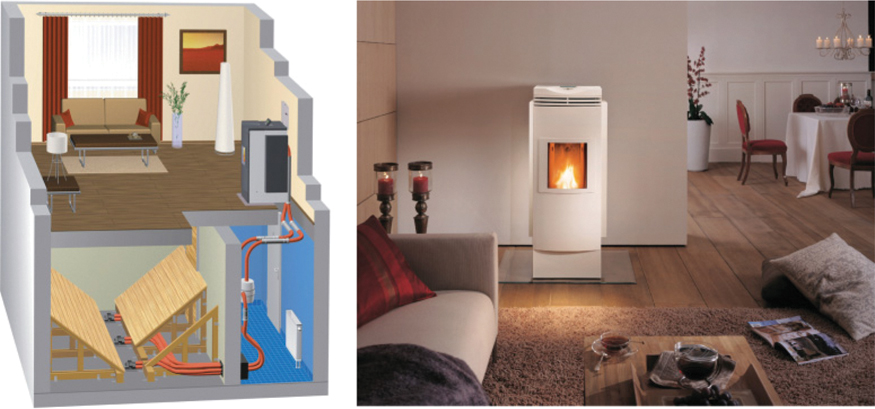
Figure 12.10 Pellet boiler for living area use with pellet store in a basement.
Source: Windhager Zentralheizung.
12.3 Biomass Heat and Power Plants
In addition to being burnt in stoves and boilers for heating systems in single homes and apartment blocks, biomass can also be used in large heat plants. A central heat plant consists of a high-performance boiler and a fuel store. The fuel store is usually big enough to ensure that independent operation can be guaranteed for several days or even weeks. A district heating grid then transports the heat to the consumers connected to the grid (Figure 12.11).
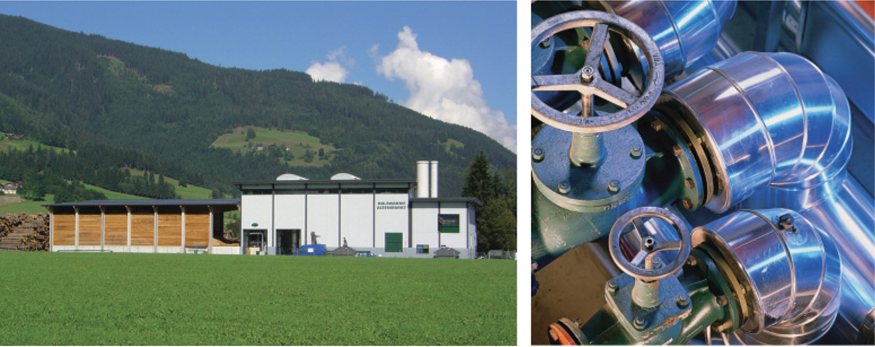
Figure 12.11 The Altenmarkt (Austria) biomass cogeneration plant and district heat distributors.
Source: Salzburg AG.
With centralized heat plants, individual consumers no longer have to worry about fuel procurement and system maintenance. These tasks are handled by the operator of the heat plant. The efficiency of large heat plants is often somewhat higher than that of small non-central systems. On the other hand, heat losses are higher because of the long pipes in the district heating grid. However, large heat plants fare considerably better when it comes to the emission of harmful substances. Compared to heating systems in single-family homes, large plants use more modern filtering techniques and have stricter conditions on emissions. This ensures that combustion gases emit fewer harmful substances.
Electricity generation is another important application of biomass. Centralized systems that are used exclusively to generate electricity are called power plants. Biomass power plants function in a similar way to coal-fired power plants. The fuels used include wood residue, wood shavings and straw. A steam boiler burns the biomass and produces steam that drives a steam turbine and an electric generator. The principle of steam power plants is explained in the section on parabolic trough power plants in Chapter 7.
Compared to photovoltaic systems and wind turbines, electricity generated by biomass power plants is not dependant on local weather conditions. Biomass fuels are ideal for storage and can be used as and when needed. This makes biomass power plants a viable supplement to other renewable energy plants. They can guarantee electricity supply in situations when there is both little wind or sun available.
In contrast to coal-fired plants that can output more than 1000 mW of power, biomass plants have a considerably lower output in the order of 10–20 mW. The use of biomass fuels is one of the main reasons for this. Biomass fuels usually come from the region where the power plant is located.
Numerous new biomass power plants have recently been built all over the world. One example is the Königs Wusterhausen biomass power plant near Berlin, Germany (Figure 12.12). This power plant has an output of 20 mW and supplies 160 million kilowatt hours per year, which can cover the electricity demand of around 50 000 households. For fuel it uses 120 000 tons of waste and wood residues from the Berlin region annually. The efficiency of this biomass plant is around 35%.
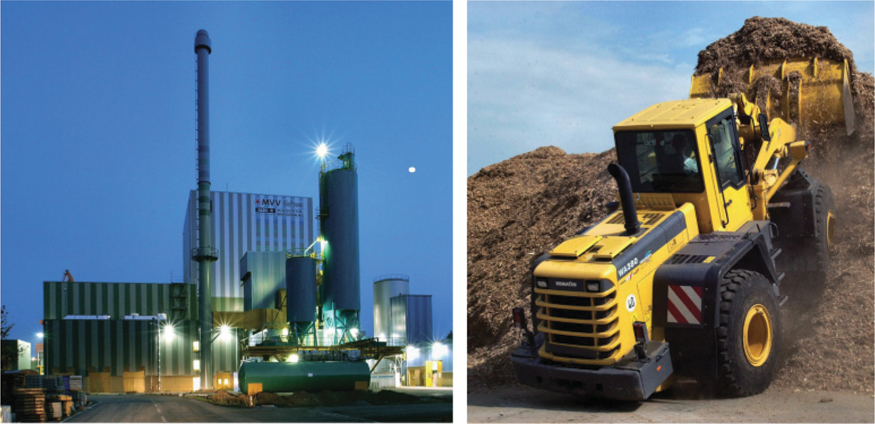
Figure 12.12 The Königs Wusterhausen biomass power plant in Germany (left) and a wheel loader for biomass fuel transport (right).
Source: MVV press photo.
Apart from its use in power plants, biomass is also appropriate for cogeneration or combined heat and power (CHP) plants. In addition to electricity, these plants produce heat which district heating grids distribute to consumers. CHP plants generate both power and heat, which is known as cogeneration. CHP plants tend to utilize the biomass fuel more effectively than pure power plants that only generate electricity. The important thing is that a buyer can always be found for the heat that is generated. In summer the heat is often not needed, and in this case, a CHP plant may operate under less favourable conditions than a plant that is optimized for power generation.
CHP plants can be smaller, so that they can be suitable for industrial buildings and even individual houses or apartment blocks. They are usually offered as cogeneration units with a modular configuration. However, the efficiency of smaller systems is frequently lower than that of larger, centralized systems. In addition to solid fuels like wood shavings and pellets, cogeneration units use biofuels and biogas.
12.4 Biofuels
Liquid and gaseous biofuels are more versatile than wood. In addition to generating heat and electricity, biofuels can be used directly as fuel in the transport sector, replacing petrol and diesel. Production methods are available that can convert different biomass raw products into biofuels. Unlike with food production, the prefix ‘bio’ in this case does not stand for controlled organic cultivation with minimum effect on the environment. On the contrary: the raw materials for biofuels are usually produced using conventional farming methods.
12.4.1 Bio-oil
The biofuel that is the easiest to produce is bio-oil. Over 1000 oleaginous plants can be used for the production of bio-oil. The most popular ones are rapeseed oil, soya oil, and palm oil (Figure 12.13). Oil mills produce the vegetable oil directly through either pressing or extraction processes. The residue from the pressing can be reused as animal feed.
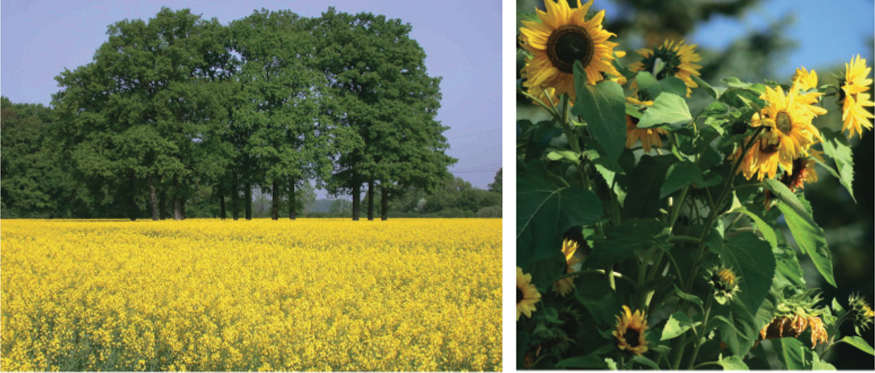
Figure 12.13 Oil-rich plants such as rapeseed and sunflowers are raw material for vegetable oil.
Source: Left: Günter Kortmann, North Rhine-Westphalia Chamber of Agriculture.
Very few older pre-combustion chamber diesel engines can be run on vegetable oil unless they have been converted. Even engines like the Elsbett engine, which were specifically developed to run on vegetable oil, have not yet achieved any significant market share. Vegetable oil is somewhat tougher than diesel fuel and needs higher temperatures to ignite. However, even normal diesel engines can be adapted and converted to run on vegetable oil.
12.4.2 Biodiesel
Biodiesel comes closer to having the characteristics of conventional diesel fuel than pure vegetable oil. Vegetable oil and animal fat are the raw materials used to produce it. The Belgian G. Chavanne applied for a patent for a method to produce biodiesel as early as 1937. Chemically, biodiesel is fatty acid methyl ester (FAME).
In Central Europe rape is normally used to produce biodiesel. Oil mills extract the raw rapeseed oil from rapeseed. Rapeseed meal is a by-product, which usually ends up in the animal feed industry. Rapeseed oil methyl ester (RME) is then created from the rapeseed oil in a transesterification facility.
 Production of Rapeseed Methyl Ester (RME)
Production of Rapeseed Methyl Ester (RME)
For the production of RME, rapeseed and methanol together with a catalyst such as a caustic soda solution are placed in a reaction vessel at temperatures of about 50–60 °C. This produces the desired RME as well as glycerine:
Biodiesel can be used as a substitute for fossil diesel fuels based on crude oil. It is available at many petrol stations in Germany. The engine manufacturer's specifications should stipulate whether a vehicle can run on pure biodiesel. If an engine is not designed for use with this fuel, there is a danger that the biodiesel will eventually destroy the hoses and seals and cause engine damage. Small quantities of biodiesel can be mixed with conventional diesel without a problem, even without approval by the manufacturer. In 2016, biodiesel accounted for 3.2% of the final energy consumption in the transport sector. However, the positive environmental impact of biodiesel is not undisputed.
![]()
Union for the Promotion of Oil and Protein Crops Information from the Agency for Renewable Resources |
12.4.3 Bioethanol
Sugar, or glucose, starch and cellulose are used to produce bioethanol. The raw materials include sugar beet, sugar cane, and grains (Figure 12.14). Sugar can be fermented directly into alcohol. On the other hand, starch and cellulose must first be broken down.
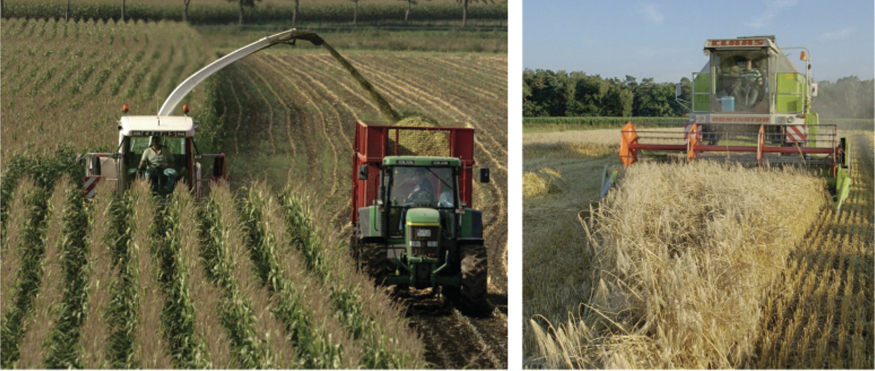
Figure 12.14 Corn and other cereals are raw materials for bioethanol production.
Source: Günter Kortmann, North Rhine-Westphalia Chamber of Agriculture.
 Production of Ethanol from Glucose
Production of Ethanol from Glucose
Glucose can be converted directly into ethanol in a hermetically sealed environment through fermentation with yeast:
Carbon dioxide is a by-product of this reaction. As plants absorb carbon dioxide again during their growth, this reaction does not actually emit any greenhouse gases. The result of the fermentation is mash with an ethanol content of around 12%. Raw alcohol with a concentration of over 90% is extracted through a distilling process. Dehydration over molecular sieves then finally produces ethanol with a high degree of purity. The waste from the ethanol production can be processed into animal feed. The amount of energy required to extract the alcohol is relatively high. If this energy comes from fossil fuels, then the effects of bioethanol on the climate are not favourable. In extreme cases, the impact can even be negative.
Bioethanol can easily be mixed with petrol. An E number indicates the ratio of the mixture. E85 means that the fuel content is 85% bioethanol and 15% petrol. In some countries small quantities of bioethanol are added to petrol. This is not a problem if the ethanol portion is 5% or less. Normal petrol engines can even be run with an ethanol portion of 10% (E10) without requiring any modification, although they should be approved by the manufacturer for this purpose. Engines must be modified for the use of ethanol for anything above that level.
In Brazil flexible-fuel vehicles are very popular. These automobiles can be filled with different mixtures including an ethanol portion of between 0% and 85%. Production facilities that use rye, corn, and sugar beet as raw materials in bioethanol production have also been established in other countries. However, the recent sharp rise in food prices has significantly worsened the economic efficiency of bioethanol production.
12.4.4 BtL Fuels
In the case of pure vegetable oil, biodiesel, and bioethanol, only the parts of a plant that are rich in oil, sugar, or starch can be used to extract fuel. The second generation of biofuels is aimed at overcoming this drawback. The abbreviation BtL stands for ‘biomass-to-liquid’ and describes the synthetic production of biofuels. Various raw materials, such as straw, biowaste, wood residue, and special energy-rich plants, can be used in their entirety in this process. The result is a major increase in the potential and possible land area yield for the production of biofuels.
The production of BtL fuels is relatively complex. The first stage is gasification of the biomass raw materials. Through the addition of oxygen and steam a synthesis gas consisting of carbon monoxide (CO) and hydrogen (H2) is produced at high temperatures. Various gas purification stages separate out carbon dioxide (CO2), dust, and other impurities such as sulphur and nitrogen compounds. A synthesis process converts the synthesis gas into fluid hydrocarbons.
The best-known synthesis process is the Fischer-Tropsch process developed in 1925. Named after its developers Franz Fischer and Hans Tropsch, this process is carried out at a pressure of around 30 bars and temperatures above 200 °C using catalysers. During the Second World War this process was widely used in oil-poor Germany to extract much sought-after liquid fuels from coal. A different procedure then produces methanol from the synthesis gas and processes it further into fuel. During the final production processing stage, the liquid hydrocarbons are separated into different fuel products and refined (Figure 12.15).
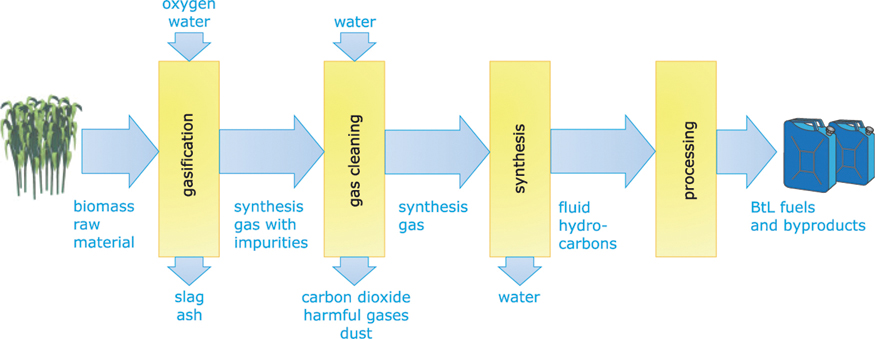
Figure 12.15 Principle of the production of BtL fuels.
BtL fuels have not yet reached a stage where they are ready for mass production. Various companies are currently experimenting with prototype facilities for producing synthetic biofuels. The main advantage of BtL fuels is that they can replace conventional fuels directly, without the need for any engine modifications. However, BtL fuels are comparatively expensive because of the complex production procedures involved.
12.4.5 Biogas
In addition to its use in the production of liquid fuels, biomass can also be used in biogas plants to produce biogas. In this process bacteria ferment biomass raw materials in a moist, hermetically sealed environment. The centrepiece of a biogas plant is the heated fermenter (Figure 12.16). A stirring device mixes the substrate and ensures that homogeneous conditions exist. The biological decomposition process mainly converts the biomass into water, carbon dioxide, and methane. The biogas plant captures the gaseous components. The biogas extracted in this way consists of 50–75% combustible methane and 25–45% carbon dioxide. Other components include steam, oxygen, nitrogen, ammonia, hydrogen, and sulphur hydrogen.
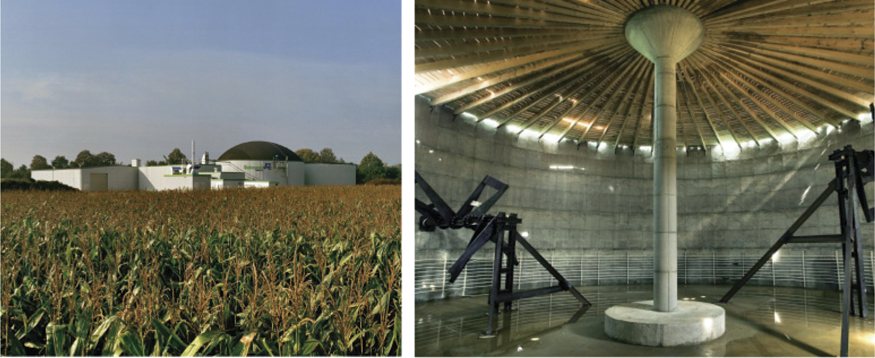
Figure 12.16 Biogas plant in a cornfield and view of interior with stirrer.
Source: Schmack Biogas AG.
In subsequent stages the biogas is purified and desulphurized. It is then stored in a gas storage tank. The biogas yield varies considerably depending on the type of biomass substrate. Whereas with cow dung the gas yield is around 45 cubic metres per ton, with corn silage the yield is at least 200 cubic metres per ton.
Biogas is used mostly in internal combustion engines. Petrol engines and modified diesel engines are both appropriate. If the engine drives an electric generator, it can produce electric power from biogas. The waste heat from the engine is also useable.
After further processing, biogas can be fed directly into the natural gas grid. This requires the removal of any trace gases, water, and carbon dioxide. Green gas suppliers are now marketing feed-in biogas in some parts of Germany. Switching to this type of gas supplier will actively promote the expansion of biogas production.
12.5 Planning and Design
The possibilities for using biomass are extremely diverse, and would merit an entire book all to themselves. Therefore, this section confines itself to the planning and design of log boilers and pellet heating systems. Both systems are especially relevant to single-family homes.
12.5.1 Log Boilers
Certain facts need to be determined before a log boiler is installed. Wood-fired systems may save on carbon dioxide, but they release harmful substances such as dust and carbon monoxide. As a result, the use of solid fuels is regulated in some cities and towns. Your local chimney cleaning company can be contacted to clarify these conditions. A log boiler also requires sufficient storage area for firewood and a suitable chimney for operation.
If no impediments to the installation exist, the next step is deciding on the dimensions of the log boiler system. The performance of the boiler should at least comply with the rated building heating load, in other words the maximum expected heat demand. A boiler has to run constantly when outdoor temperatures are very low. It is best to have a boiler large enough so that it only has to be filled up once a day under average heating conditions.
 Boiler Output and Buffer Storage Size for Log Boilers
Boiler Output and Buffer Storage Size for Log Boilers
The minimum rated boiler output ̇![]() results from the rated burning period of one re-stocking of fuel TB and the rated building heating load ̇
results from the rated burning period of one re-stocking of fuel TB and the rated building heating load ̇![]() :
:
With a building heating load of 10 kW, which approximately corresponds to that of an average single-family house that has been upgraded with energy efficiency in mind, the rated output of a boiler based on a rated burning period of 2.5 hours is:
The required buffer tank volume VT can be approximated from the rated boiler output ![]() and the rated burning time TB:
and the rated burning time TB:
As a result, the buffer tank can absorb the total heat quantity of a boiler with a fully stocked combustion chamber. A rated boiler output of 29 kW and a rated burning time of 2.5 hours results in a tank volume of
12.5.2 Wood Pellet Heating
The general guidelines on log-based heating systems can also be applied to wood pellet heating. As pellet heating systems normally transfer fuel automatically to the burner, there is no loss of comfort due to the frequent firing-up of the system during the day. The rated boiler output can therefore be designed specifically for the heating energy demand of a building. A buffer tank is still useful as it prevents a boiler from firing up too frequently and ensures that the heating system is working at its rated load most of the time. The system then burns at an optimal level and produces a minimal emission of noxious substances.
Unlike split logs, wood pellets are usually stored in a special area within a building. Pellets should not be stored outdoors, as they will absorb moisture and may become damaged. An area of three to five square metres should normally be sufficient as a pellet store for a standard single-family new-build home. Older buildings need more space, whereas well-insulated houses may require considerably less.
The transport system for the pellets is on the floor of the store (Figure 12.17). A slanted shelf will ensure that the pellets slide down to the transport system even when the filling level is low. However, slanted shelves create a void that reduces the useable storage volume to about two-thirds of the space volume. As the price of wood pellets varies throughout the year, the store should hold at least a year's worth of fuel. Pellets can then always be bought at times when prices are low.

Figure 12.17 Cross-section of a wood pellet store.
 Size of the Wood Pellet Store
Size of the Wood Pellet Store
If the annual heat demand QH and the boiler efficiency ηboiler are known, the storage room volume Vstore including any empty space can be calculated:

If the annual heat demand is not known, an estimate can be made on the basis of 200 kWh per square metre of living area for an average building, 70 kWh m−2 for a standard new-build according to EnEV 2009 (50 kWh m−2 according to EnEV 2013) and 30 kWh m−2 for a ‘three-litre’ low-energy house, based on Central European climatic conditions. In addition, there is the heat demand for heating water.
According to EnEV 2009, for a new building with 130 m2 living space, for example, this results in an annual heating requirement of 9100 kWh. Assuming 2000 kWh for hot water, the total heat demand is 11 000 kWh. With an average boiler efficiency ηboiler of 80% = 0.8, this results in a tank volume of

A storage space with a floor area of 2 m × 2 m and a height of 1.73 m would be sufficient in this case. Delivery charges per ton are generally lower for larger quantities. It is important that optimal storage conditions exist so that the pellets do not suffer long-term damage due to high air humidity.
![]()
Further information available from Pellet Fuels Institute |
 Steps to Installing Bio Mass Heating
Steps to Installing Bio Mass Heating
- Determine type of fuel. Split logs, perhaps using one's own wood. Wood pellets – for fully automated operation.
- Determine heat demand and heat output, perhaps based on existing heating system.
- Can insulation help to reduce the heat requirement?
- Dimension of store – is adequate storage space available? Is sufficient space available for a buffer tank? Is the chimney suitable for a biomass system?
- Perhaps consult a chimney sweep regarding regulations concerning system operation and residue removal.
- Request quotations for biomass heating systems.
- Examine favourable financing conditions within the framework of other climate-protection measures, check and apply for available grants.
- Arrange for system to be installed by a qualified company.
12.6 Economics
Trying to predict the long-term economic development of biomass fuels compared to fossil fuels is a bit like reading tea leaves. This is illustrated by the fluctuation in wood pellet prices over recent years (Figure 12.18). Whereas in 2003 the prices for heating oil and wood pellets of a comparable calorific value were practically the same, in 2005 oil prices soared by 50%. This caused a boom in the demand for wood pellets, which the industry had a hard time in achieving. In late 2006 the prices for wood pellets were even higher than comparable crude oil prices for a short time. The prices normalized a few months later, and oil prices again rose sharply. During the economic crisis at the beginning of 2009 and in 2015 a similar thing happened.

Figure 12.18 Comparison of end user prices for oil, natural gas, and wood pellets.
Source: German Federal Statistical Office and German Energy Pellets Association.
The potential for producing wood pellets is far from sufficient to supply the entire current heating market. If more and more customers start using wood pellets as fuel, the result will inevitably be a rise in prices. However, as fuel oil prices will also continue to move upwards in the long term, the price advantage of wood pellets could be maintained at a rising level.
Whether wood pellet heating makes economic sense depends primarily on the price difference compared to fuel oil and natural gas. An estimate for installing a wood pellet heating system is around €15 000, which is considerably more than it would be for oil or natural gas heating. However, there are no costs for the natural gas connection in a new building. The cost advantage of wood pellets compared to oil and gas is in the lower running costs of pellet heating. Depending on usage and the price development of fuels, wood pellet heating can be paid back in just a few years. The fuel prices for log-based heating systems are lower than for pellet systems. The operating costs are therefore even lower.
The German Federal Office of Economics and Export Control (BAFA) promotes the installation of automatically fed biomass boilers and log wood gasification boilers in Germany. However, the current funding conditions vary relatively frequently and can be found on the internet. If biomass heating is part of a refurbishment or an ecological new building project, in certain cases a low-interest KfW loan can also be taken out for financing.
![]()
German Federal Office for Economic Affairs and Export Control KfW development bank Current prices for biomass fuels |
The price development of biofuels in Germany is clearly heading for increases. Until 2006, biofuels such as vegetable oils or biodiesel were exempt from the mineral oil tax. As a result, their price at the pump was significantly lower than that of conventional diesel or petrol. However, with the spread of biofuels, tax shortfalls also increased. Tax rates for biofuels and fossil fuels were therefore adjusted until 2012. By then, the tax rate for vegetable oil and biodiesel had risen to 45 cents per litre. A cost advantage of these fuels is therefore no longer given. In order to avoid bringing the market for biofuels to a complete standstill, a blending obligation for biofuels to gasoline and diesel has been in force in Germany since 2007.
The demand for biofuels is clearly increasing worldwide due to high oil prices and the simultaneous increase in energy demand. This is also putting additional pressure on food prices. Grain and corn prices have reached new record levels in recent years. This development has also raised some ethical issues. Is it right that the quantity of food products being processed into biofuels is increasing when more and more people are unable to afford basic food as it is? An alternative is offered by second-generation biofuels such as BtL fuels and biogas, which can be produced from the non-edible parts of plants.
In Germany, the Renewable Energy Sources Act regulates the remuneration rates for biomass power plants. The tariffs can differ considerably depending on the biomass fuel used and the power plant output. In 2012, the feed-in-tariffs ranged from 3.98 cents per kilowatt hour for a 10-mW power plant using methane up to 14.3 cents per kilowatt hour for a 150-kW biomass power plant. Small anaerobic sewage digestion plants were even awarded 25 cents per kilowatt hour. The tariff is based on the year a plant starts operation and is then valid for 20 years. The remuneration rates for newly constructed landfill, sewage, and mine gas power plants are reduced by 1.5% per year and for biomass power plants by 2.0%. Tenders for biomass power plants started in 2017 and the first tender in 2017 resulted in an average price of 14.3 cents per kilowatt hour.
12.7 Ecology
Biomass has also come under fire for ecological reasons. For example, a farmer in Indonesia who sets fire to a hectare of rainforest in order to grow palm oil for biodiesel to sell to Europe or North America is certainly not helping to protect the climate. Priority should only be given to the sustainable production of biomass raw materials if biomass really is to offer a long-term ecological alternative to fossil fuels.
12.7.1 Solid Fuels
As explained earlier, biomass use is carbon-neutral. During its growth biomass absorbs as much carbon dioxide as it releases again when it is burnt. However, the prerequisite is that the use of biomass is sustainable. Therefore, the amount of biomass that is used should be no higher than what grows back again.
In many countries, solid biomass fuels such as wood and straw usually come from forestry or grain farming in nearby areas. Although the felling of trees, their transport, and finally the processing into fuel creates indirect carbon dioxide emissions, these emissions are comparatively low. For cut wood from the direct vicinity they are almost zero. If one takes into account the indirect carbon dioxide emissions that result from the production and the transport of wood pellets in an overall balance sheet, the carbon dioxide emissions from wood pellet heating are still around 70% lower than those of natural gas and more than 80% lower than those of oil heating (Figure 12.19).

Figure 12.19 Environmental balance sheet for the use of biomass fuels.
The harmful substances that build up when biomass is burnt create a far greater problem than indirect carbon dioxide emissions. Whereas large biomass power plants have sophisticated filtering systems, single-family homes mostly use their heating systems without any filtering mechanism. The blackened chimneys of their fireplaces testify to this. Even if the carbon dioxide balance sheet turns out to be on the plus side, biomass heating can release all sorts of other harmful substances into the environment if it is not burnt properly. In Germany today, the emission of harmful fine dust from wood-burning plants is already of the same order as that of motorized street traffic. Yet there are clear differences depending on the type of heating system used. Due to their poor efficiency, open fireplaces generally cause particularly high emissions. Therefore, the use of open fires is banned in many places.
When dry firewood or standardized wood pellets are used in modern boilers, the emission values with the same heat output can be 90% lower than with a fireplace. Different companies are now working on producing filters to prevent the emission of dust from small systems.
12.7.2 Biofuels
The ecological impact of biomass fuels is even more controversial. Tractors and farm machinery emit carbon dioxide just by being turned on. Added to this is the amount of energy required to produce fertilizer and pesticides. Nitrogen fertilizers increase nitrous emissions, which are harmful to the environment. Even the processing of biomass raw materials to produce biofuels is energy-intensive. Huge quantities of carbon dioxide are created if the energy needed comes from fossil energy sources.
The real difficulty in evaluating biomass fuels and their ecological impact is illustrated by the example of biomass cultivation in tropical rainforest regions – a topic that has recently been a target of criticism. When tropical rainforests are cleared to cultivate biomass, considerable quantities of carbon dioxide are released through the usual slash and burn methods. The subsequent cultivation of raw materials for the extraction of biofuels then has a negative environmental impact for many years. In other words, from an environmental perspective, it would have been better to burn crude oil from the start.
On the other hand, the results of the production of bioethanol on existing farmland in Brazil are better than in Germany or the USA. Factories in Brazil mostly burn the sugarless residue of sugar cane and extract the energy from this for ethanol production. As a result, ethanol production there is largely carbon-neutral. Other countries use substantial quantities of fossil fuels to do the same thing. This can totally cancel out the climate benefits of bioethanol.
Another critical point with biomass fuels is their limited development potential. If all the available land in the world were devoted to growing biomass for biofuels, it would still probably not be enough to allow biofuels to replace total oil requirements. The second-generation fuels would not totally invalidate this argument but would at least defuse it. If one removes one's own energy needs for fuel production, the net yield per hectare with BtL fuels is around three times higher than with biodiesel (Figure 12.20). The land utilization of solar systems is clearly more efficient than this. In Germany and Great Britain a photovoltaic system with 15% efficiency can generate around 495 000 kW h of electric power per year on 1 ha of land or 200 000 kilowatt hours per acre. This corresponds to a converted diesel equivalent of more than 50 000 l ha−1.

Figure 12.20 Fuel yield per hectare for different biofuels (1 hectare = 2.47 acres).
Source: [FNR06].
12.8 Biomass Markets
Biomass use varies widely in different parts of the world. Biomass is by far the most important energy source in the poorest countries of the world and in some countries even constitutes more than 90% of primary energy needs (Figure 12.21).

Figure 12.21 Biomass share of primary energy demand in different countries, incl. waste, 2015.
Source: [IEA18].
The reasons for this are mainly economic. Most people in these countries simply cannot afford crude oil, natural gas, or electricity from coal-fired power plants. In most industrialized countries like Britain, Germany, and the USA the biomass share is well below 10%. The only exceptions are countries like Finland and Sweden, which are densely wooded and sparsely populated.
Biomass is used very differently by industrialized and developing countries. In many developing and emerging countries biomass is still used in the traditional way.
These countries see the main use of biomass as firewood for cooking. Industrialized countries, on the other hand, focus on so-called modern forms of biomass use. These include convenient biomass heating systems, biomass power plants, or biofuels. The proportion of modern biomass is also increasing in industrialized countries. For example, Sweden had set itself a target of becoming independent of crude oil by 2020 mainly through an increase in biomass use but it is not on course to meet this target.
The potential is lower in more densely populated countries like Germany and Britain. But even in these countries a 10% biomass share in primary energy requirements is conceivable in the long term. Between 1997 and 2010 the biomass share of end energy demand in Germany approximately quadrupled, and now makes up almost 10% of the total energy demand (Figure 12.22).
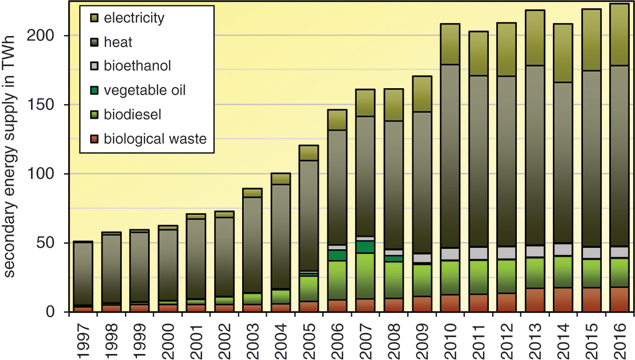
Figure 12.22 Development of biomass use in final energy supply in Germany.
Source: [BMWi17].
12.9 Outlook and Development Potential
As the economies of the developing countries grow, the contribution of traditional biomass sources to their energy supply will fall. On the other hand, high oil prices and pressure to act on environmental protection measures will drive the use of modern biomass. Biomass is capable of directly replacing fossil energy sources without needing other technologies to do so. However, the potential of biofuels is not sufficient to replace oil completely. Furthermore, the eco-balance of some biofuels is hotly disputed. However, the potential of biofuels is not sufficient to replace oil completely. There are also ethical concerns about the growing competition with food production. BtL fuels and biogas could be an alternative on a smaller scale.
Biomass power plants will become increasingly important in meeting electricity demand, not least because these plants are able to compensate for some of the major fluctuations in output provided by wind turbine and photovoltaic systems. Biomass will also play a bigger role in providing heat energy. It will therefore remain one of the most interesting renewable energy sources for the future. Throughout the industrialized countries biomass has the potential to achieve a double-digit share of energy supply. Further developments in modern filtering systems are needed to address the problem of harmful substances and fine dust in biomass burning. However, special attention should be given to the sustainable use of biomass raw materials. This is the only way in which it can make a noticeable contribution towards protecting the climate.
